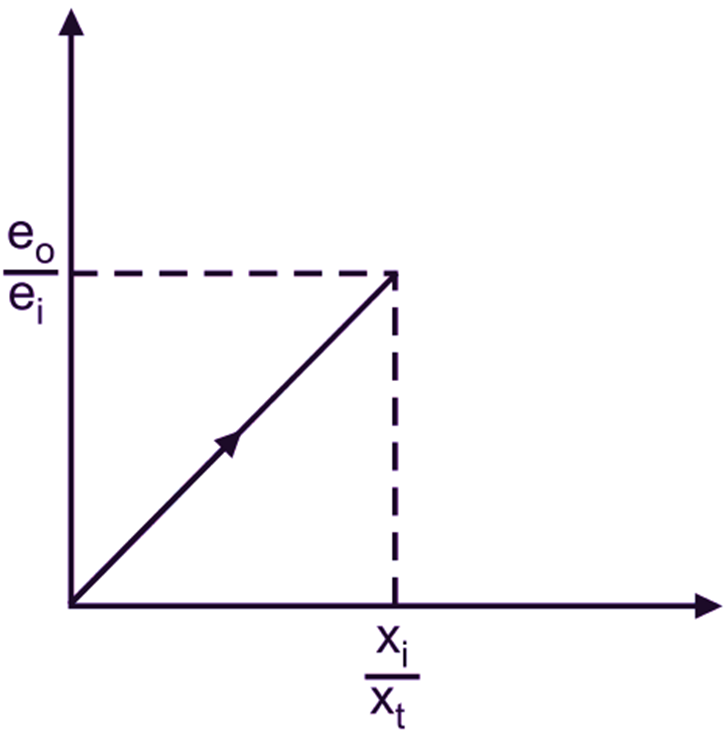This is a device, which converts mechanical displacement (to be measured) into an electrical output. Linear potentiometer can measure displacements in the range of 2.5 mm to 500 mm.
Principle of Working of Linear Potentiometer
“Change in the position of slider leads to change in resistance of potentiometer wire and corresponding change in output voltage generated is a measure of displacement of slider to be measured”.
Construction of Linear Potentiometer
Linear potentiometer consists of a stretched resistance wire and a sliding or movable contact (wiper). The resistance element or resistance wire is made up of metal alloy. This resistance wire is wound on a former in such a way that, the slider or Wiper may be moved along the various turns axial y (i.e. translational or rectilinear movement). Former is a cylindrical piece made up of an insulating material, such as, ceramic or plastic. Former is also known as mandrel. The slider or wiper always maintains an electrical contact with the resistance wire and moves over it. The component, whose displacement is to be measured, is attached to slider or wiper. Linear potentiometer is also called as ‘Linear POT’.
Working of Linear Potentiometer
Linear potentiometer is a passive transducer because it requires external power source for its operation (Fig. 1). Therefore, the resistance wire is excited with either AC or DC voltage. It is represented as input voltage (ei). When the slider moves or slides axially along the various turns of resistance wire, the effective resistance existing between one end of wire and slider also changes. Due to this, an output voltage (eo) is generated, which can be measured. Alternatively, this output voltage generated can be directly calibrated to give displacement. The output voltage generated is a linear function of the displacement to be measured.

Fig. 2.2: Linear Potentiometer
Linear displacement of slider and hence, the component is calculated by using the following mathematical relation,
\[{{\text{x}}_{\text{i}}}\text{ = }{{\text{x}}_{\text{t}}}\times \left( \frac{{{\text{e}}_{\text{o}}}}{{{\text{e}}_{\text{i}}}} \right)\]
where,
ei = Input voltage
eo = Output voltage
xt = Total length of linear pot (i.e. translational potentiometer)
xi = Displacement of slider from its zero position
R = Total resistance of potentiometer in Ω (ohms)
Above mathematical relation of xi can be derived in the following manner. If the variation of resistance with respect to displacement is linear, then resistance per unit length is given by (R/xt).

Fig. 2: Linear Potentiometer circuit diagram
The output voltage under idea condition is given by,
\[{{\text{e}}_{\text{o}}}~=\left( \frac{\text{Resistance of output terminals}}{\text{Resistance of input terminals}} \right)\times \text{Input voltage}\]
\[=\frac{\left( \text{R}/{{\text{x}}_{\text{t}}} \right)}{\text{R}}\times {{\text{e}}_{\text{i}}}\]
\[{{\text{e}}_{\text{o}}}~=\frac{{{\text{x}}_{\text{i}}}}{{{\text{x}}_{\text{t}}}}\times {{\text{e}}_{\text{i}}}\]
\[\frac{{{\text{e}}_{\text{o}}}}{{{\text{e}}_{\text{i}}}}~=\frac{{{\text{x}}_{\text{i}}}}{{{\text{x}}_{\text{t}}}}\]
\[{{\text{x}}_{\text{i}}}~=\left( \frac{{{\text{e}}_{\text{o}}}}{{{\text{e}}_{\text{i}}}} \right)\times {{\text{x}}_{\text{t}}}\]
Under ideal circumstances, the output voltage varies linearly with displacement (Fig. 3).

Fig. 3: Input-output Relationship of Potentiometer
Advantages of Linear Potentiometer
- Low cost.
- Simple to operate.
- Useful for measurement of large amplitudes of displacement.
- Electrical efficiency is very high and provides sufficient output to a low control operations.
- Rugged construction.
- Low maintenance.
- Less error in measured value, since reading is not affected due to vibration and changes in temperature.
- Suitability for A.C. excitation method.
Disadvantages of Linear Potentiometer
- For linear potentiometer, a large force is required to move the slider. So, it is not suitable for small force actuation.
- If the sliding contact becomes misaligned, then operation becomes noisy.
- Resolution is poor.
- Poor dynamic response due to friction involved.
- The device has limited life due to early wear of wiper or slider.
Applications of Linear Potentiometer
- For measurement of pressure.
- For measurement of linear and angular displacement.
- Both linear and rotary type potentiometers are used in controlling audio equipment for changing loudness, frequency of audio signals etc.
- Used as position feedback devices in closed loop control systems, such as, servomechanism.